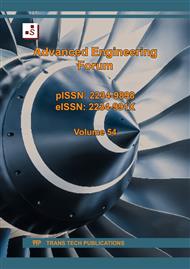[1]
Kourdourli F, Estel L, Taouk B, et al. Modeling of hydrogen production from biomass bio-digestion under Aspen Plus. Comput Chem Eng 2023; 175: 108273
DOI: 10.1016/j.compchemeng.2023.108273
Google Scholar
[2]
Martinez A, Vernieres-hassimi L, Abdelouahed L, et al. Modelling of an Anaerobic Digester : Identification of the Main Parameters Influencing the Production of Methane Using the Sobol Method. 2022; 436–448
DOI: 10.3390/fuels3030027
Google Scholar
[3]
M. Luna-delRisco AN and KO, 1Institute. Biochemical methane potential of different organic wastes and energy crops from Estonia. Agron Res 2011; 9 (1–2): 331–342
Google Scholar
[4]
Anaya W, Mazid A, Das N. Modelling and analysis for biogas production process simulation of food waste using Aspen Plus. Fuel 2022; 309: 122058
DOI: 10.1016/j.fuel.2021.122058
Google Scholar
[5]
Rajendran K, Kankanala HR, Lundin M, et al. Bioresource Technology A novel process simulation model ( PSM ) for anaerobic digestion using Aspen Plus. Bioresour Technol 2014; 1–7
DOI: 10.1016/j.biortech.2014.01.051
Google Scholar
[6]
Shivali Sahota SK and andLidia L. Biohythane, Biogas, and Biohydrogen Production from Food Waste: Recent Advancements, Technical Bottlenecks, and Prospects. energies 2024; 17(3)
DOI: 10.3390/en17030666
Google Scholar
[7]
Safiou B. An Efficient Visible Numerical Model to Find the Optimal Anaerobic Digestion Temperature in a Continuous Reactor Without Hydrolytic Microbial Compartment. (2021)
Google Scholar
[8]
Kalogirou E, Contino F. Development and application in Aspen Plus of a process simulation model for the anaerobic digestion of vinasses in UASB reactors: Hydrodynamics and biochemical reactions. J ofEnvironmental Chem Eng 2019;
DOI: 10.1016/j.jece.2019.103540
Google Scholar
[9]
Zhao X, Ngo HT, Walker DM, et al. Tri-reforming of surrogate biogas over Ni/Mg/ceria–zirconia/alumina pellet catalysts. Chem Eng Commun 2018; 205: 1129–1142
DOI: 10.1080/00986445.2018.1434162
Google Scholar
[10]
Hajjaji N, Martinez S, Trably E, et al. Life cycle assessment of hydrogen production from biogas reforming. Int J Hydrogen Energy 2016; 41: 6064–6075
DOI: 10.1016/j.ijhydene.2016.03.006
Google Scholar
[11]
Kumar N, Roy A, Wang Z, et al. Bi-reforming of methane on Ni-based pyrochlore catalyst. Appl Catal A Gen 2016; 517: 211–216
DOI: 10.1016/j.apcata.2016.03.016
Google Scholar
[12]
Xie S, Hai FI, Zhan X, et al. Anaerobic co-digestion: a critical review of mathematical modelling for performance optimization. Bioresour Technol 2016;
DOI: 10.1016/j.biortech.2016.10.015
Google Scholar
[13]
Meena RAA, Rajesh Banu J, Yukesh Kannah R, et al. Biohythane production from food processing wastes – Challenges and perspectives. Bioresour Technol 2020; 298: 122449
DOI: 10.1016/J.BIORTECH.2019.122449
Google Scholar
[14]
Kakpo MM, Ekouedjen EK, Bouraïma S, et al. Review On the Tri Reforming Process For Syngas Production With Biogas In West-Africa". Int J Curr Res 2023; 15: 25027–25037
Google Scholar
[15]
Chein RY, Wang CY, Yu CT. Parametric study on catalytic tri-reforming of methane for syngas production. Energy 2017; 118: 1–17
DOI: 10.1016/j.energy.2016.11.147
Google Scholar
[16]
Amin MH, Patel J, Sage V, et al. Tri-reforming of methane for the production of syngas: Review on the process, catalyst and kinetic mechanism. APCChE 2015 Congr Inc Chemeca (2015)
Google Scholar
[17]
Pham Minh D, Pham XH, Siang TJ, et al. Review on the catalytic tri-reforming of methane - Part I: Impact of operating conditions, catalyst deactivation and regeneration. Appl Catal A Gen 2021; 621: 118202
DOI: 10.1016/j.apcata.2021.118202
Google Scholar
[18]
Cho W, Song T, Mitsos A, et al. Optimal design and operation of a natural gas tri-reforming reactor for DME synthesis. Catal Today 2009; 139: 261–267
DOI: 10.1016/j.cattod.2008.04.051
Google Scholar
[19]
Arab Aboosadi Z, Jahanmiri AH, Rahimpour MR. Optimization of tri-reformer reactor to produce synthesis gas for methanol production using differential evolution (DE) method. Appl Energy 2011; 88: 2691–2701
DOI: 10.1016/j.apenergy.2011.02.017
Google Scholar
[20]
Wu KT, Yu CT, Chein RY. Numerical Modeling on Catalytic Tri-reforming Reaction of Methane for Syngas Production. Energy Procedia 2017; 105: 4198–4203
DOI: 10.1016/j.egypro.2017.03.895
Google Scholar
[21]
Zhao X, Naqi A, Walker DM, et al. Conversion of landfill gas to liquid fuels through a TriFTS (tri-reforming and Fischer-Tropsch synthesis) process: A feasibility study. Sustain Energy Fuels 2019; 3: 539–549
DOI: 10.1039/c8se00344k
Google Scholar
[22]
Song C, Pan W. Tri-reforming of methane: A novel concept for catalytic production of industrially useful synthesis gas with desired H2/CO ratios. Catal Today 2004; 98: 463–484
DOI: 10.1016/j.cattod.2004.09.054
Google Scholar
[23]
Froment JX and GF. Methane Steam Reforming, Methanation and Water-Gas Shift: 1. Intrinsic Kinetics. AIChE J 1989; 35: 88–96
DOI: 10.1002/aic.690350109
Google Scholar
[24]
David L Trimm and Chi-Wai Lam. The combustion of methane on platinum-alumina fibre catalysts -I. Kinetics and mechanism. Chem Eng Sci 1980; 35: 1405–1413
DOI: 10.1016/0009-2509(80)85134-7
Google Scholar
[25]
Díez-Ramírez J, Dorado F, Martínez-Valiente A, et al. Kinetic, energetic and exergetic approach to the methane tri-reforming process. Int J Hydrogen Energy 2016; 41: 19339–19348
DOI: 10.1016/j.ijhydene.2016.04.229
Google Scholar
[26]
Zhang Y, Zhang S, Gossage JL, et al. Thermodynamic Analyses of Tri-reforming Reactions To Produce Syngas. Energy Fuels 2014; 28: 2717–2726
DOI: 10.1021/ef500084m
Google Scholar


